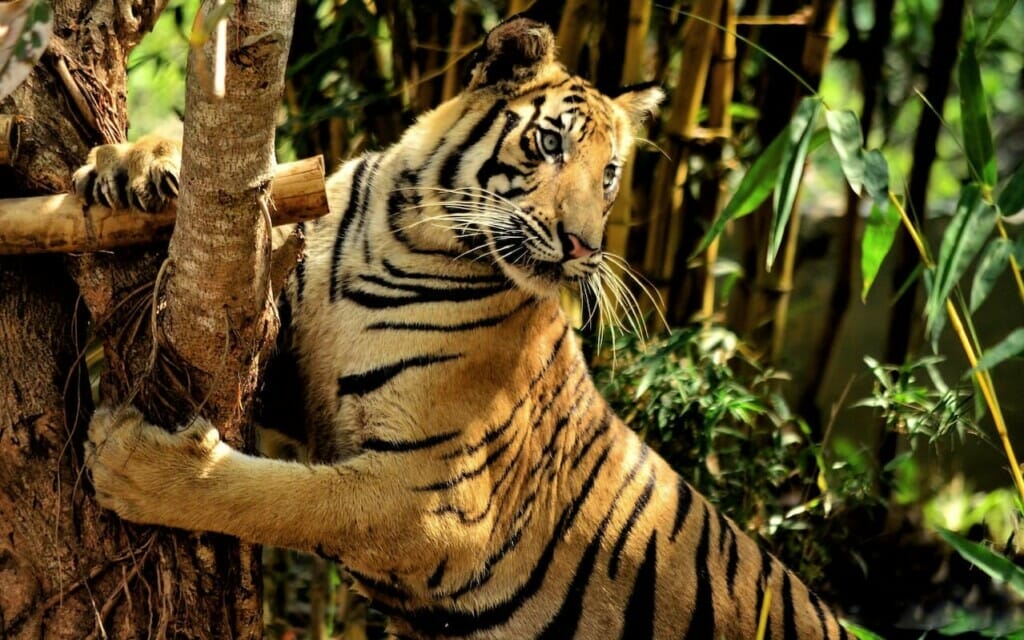The Malayan Tiger (Harimau Malaya)
Malaysia has lost 90% of its tiger population in the last 70 years. The Malayan Tiger (Harimau Malaya), Malaysia’s national symbol, is one of nine tiger subspecies, four of which went extinct in that period. The death of the tigers is seen as a “silent extinction,” as many are unaware of it.
The sad truth is that the Malayan Tiger (Harimau Malaya) is next on the list of extinction. 3,000 Tigers used to prowl the dense forests of Malaya in the 1950s, and now less than 150 tigers are left. Given the population trend over the last 100 years, the survival of the Malayan Tiger (Harimau Malaya) is less likely, and they might become extinct forever.
Why Is This Happening?
The dwindling Tiger population is not known to most people in Malaysia. The Malayan Tiger (Harimau Malaya) is on the brink of extinction due to trophy hunting, persecution, habitat loss, medication, poaching, and fragmentation. The Malayan Tiger hunting accelerated in the 1990s dua to Asia’s burgeoning affluence and its insatiable appetite for exotic wildlife, where tiger parts have been sold at exotic meat restaurants. Malayan Tigers have been slaughtered for their skin, bones, blood, and sexual organs for traditional medicines. For this reason, it is crucial to protect this species and its habitat, as they may not have the chance to survive for the next few years. One of the Weapons poachers use is snares. A snare is a long piece of wire with a loop at the end attached to a stationary object, such as a large tree or log. The coil of wire is suspended from a small tree, and the snare straggles the animal by the neck. As the animal continues to move forward, the snare pulls tighter, trapping the animal and eventually killing the animals inhumanly. The idea of snares is cruel, which is why the government and state park rangers have prioritized detaching all snares in Pahang. Furthermore, with the growing human population, excessive logging has significantly reduced the amount of rainforest used for agricultural purposes. Habitat fragmentation, commercial exploitation, and loss of food sources have also contributed to the species’ decline.
Conserving The Malayan Tiger (Harimau Malaya)
The Save the Malayan Tiger Campaign is not a short-term initiative but a long-term collaborative effort between like-minded organizations such as the military, police, forest departments, and non-governmental organizations participating in joint operations in Malaysia. The National Tiger Conservation Centre in Lanchang, Pahang, was created in 2021 to help save the Malayan Tigers. The goal is to strengthen tiger conservation in Malaysia by creating more awareness of tiger conservation-related issues. The conservation effort includes the establishment of the Pahang Wildlife Committee under the Pahang State Biodiversity council to combat poaching and logging activities in the state of Pahang. Forested corridors that have been destroyed have helped poachers to reach what used to be inaccessible areas which cause harm to the tigers. Immediate and drastic measures must be taken to disrupt the wildlife crime syndicates for targeted and illegal actions that can destroy the number of tigers.
The Fate Of Malayan Tigers (Harimau Malaya)
The fate of the Malayan Tiger hangs by its whisker if it is not elevated to the level of national emergency. The Malayan Tigers (Harimau Malaya) are Malaysia’s national animal and are portrayed in the coat of arms. Our country must prioritise the survival of these tigers, or else we will never see them again. The lives of the Malayan Tiger are in our hands, and the actions we take today will determine their future.

